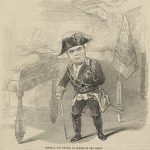The General’s Clothes and Carriage Stir Up Excitement

Every “batch” of letters I read from P. T. Barnum’s 1845 – 1846 copy book offers a rich assortment of intriguing details, and with that, I am faced with the difficult task of choosing which to highlight in my brief scribblings. I say “scribblings” because Barnum himself used the word frequently to describe his correspondence with the New York Atlas newspaper editors, to whom he provided descriptions of his travels and observations of French culture and historical places. Scattered among those lengthy epistles are Barnum’s letters to friends and business associates, as well as the people directly involved in managing Charles Stratton’s (“General Tom Thumb”) tour and performances.
Today I’d like to share some snippets illuminating ways that Barnum arranged and promoted his protégé’s performances. These are drawn from letters written between August 9 – 12, 1845, when Barnum was in Poitiers, Niort, and La Rochelle. A “thread” that caught my attention concerns the use of Tom Thumb’s clothing in the advance promotion. While Barnum was in Poitiers he wrote to his tour manager, “If you can possibly spare any more boots or shoes of the General’s send them with the other things to Bordeaux. Napoleon boots or any other.” Barnum’s letters to the man often contain firm instructions to collect the items from the places where Barnum had loaned them while engaged in his work as the advance man. “I have left one boot with the [theatre] manager—don’t forget it.”

Barnum Museum collection
Lending boots and clothing seems to have had two purposes. Some items were provided to printers so they could produce accurate illustrations, called “cuts.” This was the common term for the woodcut illustrations printers used on handbills and to illustrate newspaper advertisements. Barnum paid for cuts to be made and used, and afterwards sent on to him to be used by a printer in the next town on the tour. Barnum also seems to have loaned articles of dress for display, with the idea that firsthand viewing of one of the perfectly miniature garments would stir up public excitement. “I have left a coat of the General’s with the Hairdresser, close to the Theatre—in a first rate place—don’t forget it.” Whether this coat was one of the character costumes or gentleman’s clothing (which Barnum refers to as Charles’ citizens dress), isn’t revealed.
In the next group of extracts we get some tantalizing bits about staging Tom Thumb’s performances, and the role of the miniature equipage. Barnum wrote to his manager: “The General appears at night as Grand Frederick; the carriage enters & takes him off the stage. The carriage does not enter the Theatre in the day time. In the day time he gives the statues in his citizens dress—at night in costume.” Statues refers to poses in which Charles presented himself, emulating classical sculptures; frankly it is hard to envision him doing that in a suit! (Photos from later dates show that he wore a body stocking costume.)
In another letter Barnum gives specific instructions about the entourage’s arrival in the town of Niort: “The groom must leave Poitiers at five o’clock—you leave at ½ past 6 or certainly by 7.” The groom was charged with bringing Tom Thumb’s miniature coach and ponies, the “Equipage” that had become an important marketing tool and “brand” since the tour in England. Yet Barnum’s enthusiasm for Niort, for which he expressed high hopes in a previous letter, seems to have been quelled within a day or two of his arrival. “You will not do much here I fear. It is a large town but very dull. Still you must try. If the groom gets the Equipage in the streets by 11 o’clock, he may stir them up some. You don’t play Petit Poucet [a play written for Tom Thumb] after you leave Tours but the General imitates Frederick the Great here in the evening.”
Tom Thumb’s imitation of Napoleon was his best-known and most popular character role. But it was thought prudent to avoid imitating the French hero while on tour in France, and instead play another military hero, Frederick the Great. The costume for this character role may be what Barnum is referring to when he directed a correspondent “to go as soon as possible to Messrs Roux & Co, theatrical agents” to have them send signed contracts, and asked that, “Mr. Roux will also please send his bill for [the] General’s new clothes . . . & I will attend to it at once.” A newspaper illustration included here shows us what the Frederick the Great costume looked like.
Here at the Barnum Museum we have a wonderful array of clothing that originally belonged to “the General” and was saved over the years, including a Napoleon jacket, a court suit, “citizens dress,” boots, jewelry, and more. We also have one of Tom Thumb’s show carriages, dating to about 1850, just a few years after the European tour. Firsthand experience tells us that visitors today are just as fascinated by these artifacts as people seem to have been in the 1800s. And now you can see them no matter where you are in the world by visiting our digital collection in the Connecticut Digital Archive!
Adrienne Saint-Pierre
Barnum Museum Curator

